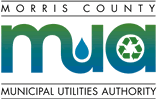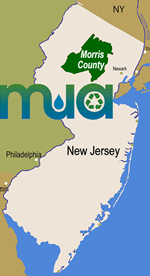Transfer Station Info (Tip Fee $115.00/ton)
- Mt. Olive Mon-Fri 7:30am-3pm; Sat 7:30am-11am
- Parsippany Mon-Fri 7am-3pm; Sat 7:30am-11am
- Closed Sundays and Major Holidays
- No Rental Trucks
- Payment by Account, Check, Credit Card. No Cash
Facility Information

1 Eden Lane
Flanders, NJ 07836
Tel: 973-347-7111 Fax: 973-691-7359
WWW: veoliaes-ts.com/Contacts/Flanders%20%20NJ
Town: Mount Olive Township
- Hours: The hours of operation and receiving are not restricted in Onyx's current permits but normal receiving hours are 6:00 a.m. through 10:00 p.m. Monday through Friday.
-
Notes: The property is 6.01 acres in size of which 3 acres comprise the total active area. The portion of the facility utilized for the transfer operations consist of a 22 bay loading dock and shipping/receiving area. These areas are 37,000 square feet.
AETS does not perform treatment or disposal of materials on-site. AETS utilizes a number of off-site facilities for treatment of waste including recycling, wastewater treatment, fuel blending, incineration, and landfill. Activities at the Eden Lane facility are limited to transfer of closed containers. Typically these containers are 2 gallons to 1 yd in size. In addition, AETS is permitted to transfer, without handling or processing, roll-off and tanker truck quantities of waste as well. These larger quantities are very infrequently received, however. Total permitted storage capacity of the facility is 170,500 gallons; the equivalent 3,100 fifty-five gallon drums. This capacity includes both RCRA hazardous and permitted to store wastes for one year. In order for AETS to accept any wastes at the Eden Lane facility, each waste stream must already have an approval for receipt in place at its intended final treatment or disposal facility.
The facility consists of a 22 bay loading dock, a 17 space storage area for full trailers, and an enclosed storage room referred to in the permit as the "shipping/receiving room". The loading dock, shipping/receiving room, and parking spaces are constructed of impervious concrete pads. All of these areas are contained by a trench drain system with manually controlled valves to prevent commingling of incompatible wastes. The trench system leads to a containment basin with an impervious concrete base. The containment system capacity is adequate to contain 10% of the total volume of containers and accumulated rain water.
Equipment such as pallet jacks, drum trucks, and forklifts are utilized to move the containers. Wastes are stored in DOT acceptable containers. Containers are compatible with waste contained within them. Ignitable and reactive wastes are stored at least 50 feet from the facility's property line. All wastes are unloaded, inspected, segregated and stored as specific in the US DOT hazardous materials regulations.
Wastes are prepared for shipment at the generator's site by highly trained AETS Field Operations personnel. All wastes are packaged, marked, labeled, loaded, and segregated as specified in the US DOT hazardous materials regulations. Containers of questionable integrity are re-packed or overpacked on the generator's site prior to shipment to the Eden Lane facility.
Waste information is entered directly into a lap-top computer at the customer site. A bar code label is generated by the field computer and placed on each container. This label includes the generator name and address, manifest number, accumulation start date, date shipped, DOT shipping description, and RCRA classification. In addition this label includes a 13 digit, alpha-numeric, container number specific to that container. This container number will never be repeated.
AETS requires a Waste Information Profile (WIP) to be completed and certified by the generator prior to waste shipment to the facility. The determination as to which treatment or disposal facility each container will be sent is made prior to pickup of the waste at the generator's site. The generator's WIP number and the treatment or disposal facility's approval code are also marked on each container via the bar code label.
Waste flow through the facility from the time of receipt to the time of shipment off site proceeds as follows:
-The current hazardous waste facility permit does not restrict AETS from receiving wastes directly from generators or third party brokers, provided those transporters delivering materials possess valid NJDEP hazardous or solid waste transporter permits. However, the vast majority of the volume received at the Flanders facility, estimated at greater than 99%, has been either transported or prepared for transport by Waste Management/AETS personnel. Regardless of AETS' level of involvement in preparation or transportation of waste materials to the Flanders facility, all provisions of the hazardous waste facility permit must be followed. This includes those provisions pertaining to waste analysis, Waste Information Profile certification, and waste tracking included elsewhere in this section of the application. Unscheduled deliveries of waste materials are very uncommon. In the event of an unscheduled delivery, all aspects of compliance with AETS' permit and other applicable NJDEP, USEPA, and USDOT are review prior to acceptance of the load.
- Trucks and trailers enter the property at the north gate and proceed to the south side of the loading dock. Bays 21 and 22 are those most often used for receiving. The load first undergoes a physical piece count, where the number of container listed on the manifests are compared to actual number of pieces received. Once the number of containers has been verified, an AETS representative signs and dates the manifests indicating acceptance of the waste.
- Containers are then transferred to either a storage trailer, the shipping receiving room, or to an outbound trailer to await shipment to the destination facility indicated on each container's label. Before loading these containers onto the outbound trailers, an additional label is placed over the portion of the incoming label that had indicated generator name and manifest number. This new label reflects AETS as the generator, and lists the outbound manifest number.
Once a load is ready for shipment to a treatment or disposal facility, the trailer is parked in the contained trailer parking areas described above to await completion of the manifests and its scheduled delivery date. Per AETS' permit, the material must be shipped off site within ten working days after the 18" aisle space in a trailer has been broken. If the material cannot be shipped off site within ten working days, the trailer must be unloaded and all containers inspected.
AETS has taken steps to assure that operations conducted at the Eden Lane facility will have no adverse effects on human health or the environment as outlined in the Facility's Part B Permit, Storm Water Pollution Prevention Plan, and Discharge Prevention Containment and Countermeasure/Discharge Cleanup and Removal Plans. AETS' success in avoiding any releases of hazardous materials to the environment can be attributed to the following:
- All wastes received by the facility are maintained in sealed and/or closed containers. (br) - AETS does not manufacture, treat or dispose of hazardous materials on site.
- All of the wastes are stored in enclosed trailers or in the shipping/receiving area inside the warehouse.
- AETS employs effective Best Management Practices (BMPs) and safety procedures which safeguard against releases.
- AETS' field and facility personnel are highly trained technicians.
- The facility features a state-of-the-art secondary containment system.In a June 5, 2007 letter, the NJDEP approved the May 10, 2007 administrative action request allowing Veolia to act a commercial collection facility for regulated medical waste.
- Capacity: The Onyx Facility's current hazardous waste permit does not limit the amount of material, hazardous and/or non-hazardous waste, that can be received and transferred on a per day basis. Rather, this permit limits the total volume that can be stored on the property at a given time. That volume is 170,500 gallons, the equivalent of 3,100 fifty-five gallon drums. This Plan amendment shall maintain the facility's maximum acceptance and storage capacity to be consistent with the hazardous waste permit the AETS Facility currently operates under.
- Limitations: As part of this Plan amendment, the Morris County Municipal Utilities Authority (MCMUA) reserves the right to direct any non-hazardous ID27 waste generated within Morris County to either its Mt. Olive transfer station and/or its Parsippany-Troy Hills transfer station if it desires those transfer stations facilities to manage those ID27 wastes. This is in accordance with the waste flow directives contained as part of the existing Plan.
- Facility Type: Transfer Station / MRF
- Permit No.: TBA
- Block and Lot: Block 4500; Lot 37
Acceptable Material - Recycling

Acceptable Material - Disposal




